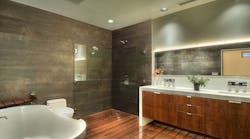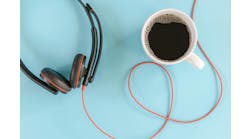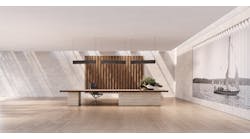In acoustics, when we joke about the worst-sounding spaces, we always refer to tiled bathrooms. Everyone knows how bathrooms sound: echoic, reverberant and loud. As children in the tub, we all loved to sing, clap and make funny noises to play with the cool, cave-like sound of being in the bathroom. As adults, bathrooms are often more than just a place for basic human function. They are a place of privacy, or even a spa-like place of serenity. Like any such space, we prefer the peace of a quiet acoustic environment.
Bathrooms are, by nature, wet and humid spaces, designed to lock in heat and moisture. The nature of this environment is the antithesis of a good-sounding acoustic space. They require waterproof, washable surfaces, which are traditionally smooth and hard, while acoustic control is traditionally soft, porous, rough and difficult to clean. This is why most bathrooms are acoustically echoic, loud and highly reverberant.
Herein lies the challenge for peaceful, quiet and serene-sounding bathroom environments. The good news is there are at least two ways to make a bathroom sound good – or at least much better:
1. Divide and conquer.
Split the space into wet and dry areas applying traditional materials. The wet areas should use traditional hard, waterproof materials that are functional with many options. These areas would include the shower, tub and sink counter. The dry areas are better off using traditional, soft, porous acoustic materials. These areas would include parts of the floor, walls opposite or far from the shower, tub and toilet. Depending on the design of the vanity, acoustic materials could optionally be applied next to and above the vanity/sink location. Large format, long-haired, 1” shag carpets could be used extensively around the space for both acoustic control and aesthetic accent. Like bath mats, they are durable and washable.
This mixed approach will help ease the loud echoes and reverb of the hard surfaces while letting the wet areas be carefree, washable and waterproof like every other bathroom. Like any surface, over time the acoustic panels will need cleaning and eventually replacement of the textile covering. Wood slat floor mats in conjunction with the long-haired shag carpets provide a slight addition of acoustic control. They also provide water control and an anti-slip feature while being aesthetic and comfortable to the touch.
► Design News | Read More Acoustics 101
2. Integrate new acoustic materials
Integrate new acoustic materials into the wet areas to control at least high frequency flutter echoes. New sheer drapery textiles are available from several large textile firms that, according to testing, have a noise reduction rating as high as 0.7. This means at mostly high frequencies, the drapery will absorb roughly 70 percent of sound energy. Draperies made from these textiles can act as a second shower curtain on the outside to control sound, while the inner curtain can keep the water from soaking the acoustic drape and keep the water inside the shower area.
All other areas such as the ceiling and walls around the vanities and tub can use new bathroom quantum devices made with natural organic materials and waterproof plastics to control all frequencies of sound, including low and mid-low frequencies. These new devices are very thin with many aesthetic options. They are manufactured with mold-resistant and waterproof materials and are easily disassembled for cleaning. For a consistent aesthetic look, the sheer drapery acoustic material can be used to wrap the quantum bathroom devices, integrating both appearance and highest performance into one slim package.
Of course, with all things, there are compromises. The more acoustics you apply in any wet area means the more cleaning they will require over time. However, this is true of all bathroom materials, from sinks and towels to bathmats. New, higher performance technology also has a higher price tag than the traditional, lower performance materials.
As with all design, acoustics for bathrooms starts with a vision, or in this case, a mental tone of what you want your bathroom to sound like. If you like to sing really loudly in the shower and sound like a rock star with lots of reverb, get a portable, battery-powered Bluetooth boom tube and have a great time. Alternatively, if you desire a quiet, rejuvenating, spa-esque space for taking long baths and meditating in the tub, surrounded by candles and a good book, then you’ll need some acoustic upgrades to create your dream space.
The Silver Bullets | Summary
The good news is bathrooms are ubiquitous. That means there are always new products introduced into the market, and they often have the benefit of being dual purpose: bathroom-friendly and good for acoustic control. Additionally, new technology and products are always developed. The large textile firms and quantum acoustic device designers continue to evolve new products to control all frequencies of sound while being water-resistant, mold-resistant and easily cleanable.
Acoustics is incredibly fun and fascinating. As the science underlying all of sound, it brings us music, language and an incredibly diverse world of intriguing sounds. It teaches us to care for our health while improving our quality of life in a variety of creative and artistic ways.


